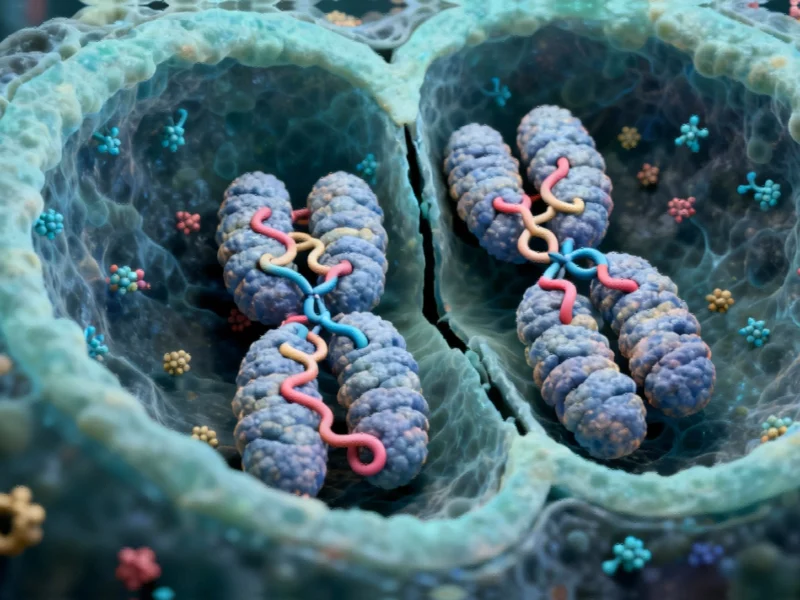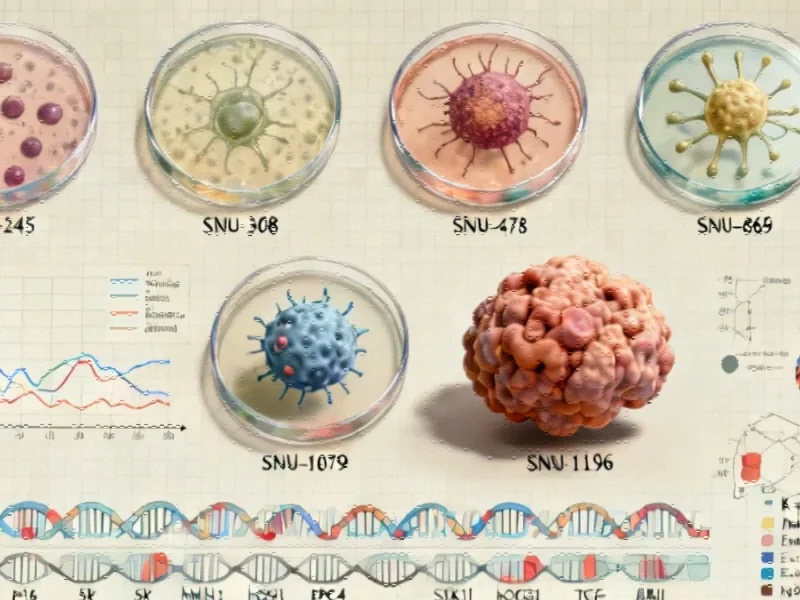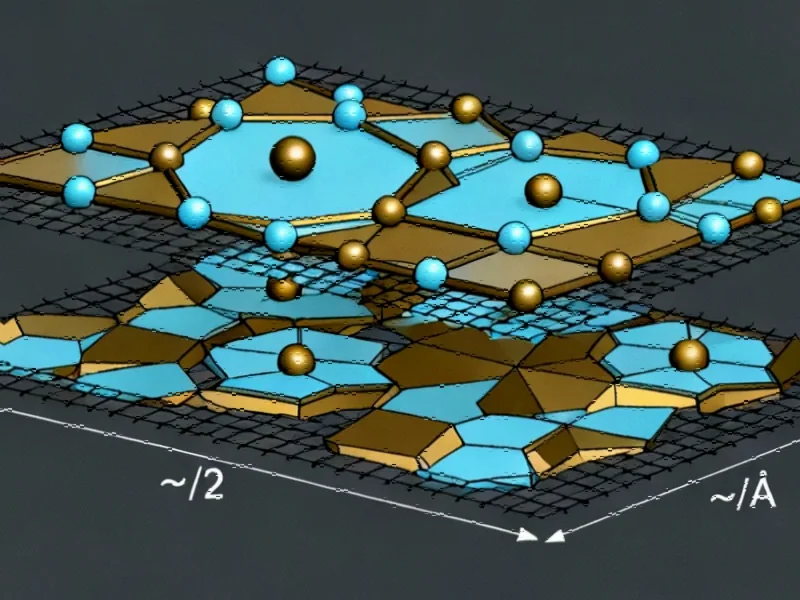In a groundbreaking discovery that challenges long-held beliefs about cellular biology, MIT researchers have found that tiny 3D loops in the genome persist during cell division, maintaining crucial regulatory connections even as chromosomes undergo dramatic compaction. This finding fundamentally reshapes our understanding of how cells preserve genetic information across generations and may explain mysterious transcriptional spikes observed during mitosis.
The study, published in Nature Structural & Molecular Biology, reveals that these microscopic loops connecting regulatory elements and genes remain intact throughout cell division, contrary to the previous assumption that the genome’s 3D structure completely dissolves during this process. As detailed in earlier research, these persistent structures may serve as cellular memory devices, helping cells maintain gene expression patterns across cell cycles.
Rethinking Mitosis: From Blank Slate to Structured Transition
“This study really helps to clarify how we should think about mitosis,” says Anders Sejr Hansen, MIT associate professor of biological engineering and senior author of the study. “In the past, mitosis was thought of as a blank slate, with no transcription and no structure related to gene activity. And we now know that that’s not quite the case. What we see is that there’s always structure. It never goes away.”
The research team discovered that these regulatory loops actually strengthen as chromosomes compact in preparation for cell division. This compaction brings genetic regulatory elements closer together, encouraging them to stick together and potentially helping cells “remember” interactions present in one cell cycle and carry them to the next.
Advanced Technology Reveals Hidden Structures
The breakthrough came through the application of Region-Capture Micro-C (RC-MC), a revolutionary technique developed in 2023 that provides 100 to 1,000 times greater resolution than previous methods. This high-resolution mapping allowed researchers to identify “microcompartments” – tiny, highly connected loops that form when enhancers and promoters located near each other stick together.
Viraat Goel Ph.D. ’25, the study’s lead author, explains: “The findings help to bridge the structure of the genome to its function in managing how genes are turned on and off, which has been an outstanding challenge in the field for decades.” This technological advancement in genomic mapping represents a significant leap forward, similar to how new telescope technology enables clearer observations of cosmic phenomena by cutting through interference.
Unexpected Persistence During Cell Division
When the researchers tracked cells through the entire cell division process, they expected the microcompartments to disappear during mitosis, as do larger genome structures called A/B compartments and topologically associating domains (TADs). Instead, they found the opposite: microcompartments remained visible and became more prominent during cell division.
“We went into this study thinking, well, the one thing we know for sure is that there’s no regulatory structure in mitosis, and then we accidentally found structure in mitosis,” Hansen recalls. This unexpected discovery parallels how investment firms sometimes uncover unexpected opportunities through careful analysis of complex systems.
Solving the Mystery of Mitotic Transcription Spikes
The findings may finally explain a long-standing mystery in cell biology: why cells experience a brief spike in gene transcription near the end of mitosis. Since the 1960s, scientists believed transcription ceased completely during cell division, but studies in 2016 and 2017 revealed this transient transcriptional burst.
The MIT team discovered that during mitosis, microcompartments are more likely to form near genes that spike during cell division. The genome compaction that occurs during mitosis brings enhancers and promoters closer together, allowing them to stick together and form microcompartments that may accidentally activate gene transcription.
“It almost seems like this transcriptional spiking in mitosis is an undesirable accident that arises from generating a uniquely favorable environment for microcompartments to form during mitosis,” Hansen suggests. “Then, the cell quickly prunes and filters many of those loops out when it enters G1.” This process of accidental activation and subsequent refinement mirrors how artificial intelligence systems sometimes generate unexpected outputs that require careful curation.
Future Directions and Biological Implications
The research team is now exploring how variations in cell size and shape affect genome structure and gene regulation. “We are thinking about some natural biological settings where cells change shape and size, and whether we can perhaps explain some 3D genome changes that previously lacked an explanation,” Hansen says.
Another crucial question remains: “How does the cell then pick what are the microcompartments to keep and what are the microcompartments to remove when you enter G1, to ensure fidelity of gene expression?” This selective preservation mechanism represents the next frontier in understanding how cells maintain identity through multiple divisions.
Effie Apostolou, an associate professor of molecular biology in medicine at Weill Cornell Medicine who was not involved in the study, notes that “this study leverages the unprecedented genomic resolution of the RC-MC assay to reveal new and surprising aspects of mitotic chromatin organization, which we have overlooked in the past using traditional 3C-based assays.”
The discovery of persistent genome loops during cell division not only rewrites textbook descriptions of mitosis but opens new avenues for understanding cellular memory, gene regulation, and potentially even cancer biology, where cell division processes often go awry.
Based on reporting by {‘uri’: ‘phys.org’, ‘dataType’: ‘news’, ‘title’: ‘Phys.org’, ‘description’: ‘Phys.org internet news portal provides the latest news on science including: Physics, Space Science, Earth Science, Health and Medicine’, ‘location’: {‘type’: ‘place’, ‘geoNamesId’: ‘3042237’, ‘label’: {‘eng’: ‘Douglas, Isle of Man’}, ‘population’: 26218, ‘lat’: 54.15, ‘long’: -4.48333, ‘country’: {‘type’: ‘country’, ‘geoNamesId’: ‘3042225’, ‘label’: {‘eng’: ‘Isle of Man’}, ‘population’: 75049, ‘lat’: 54.25, ‘long’: -4.5, ‘area’: 572, ‘continent’: ‘Europe’}}, ‘locationValidated’: False, ‘ranking’: {‘importanceRank’: 222246, ‘alexaGlobalRank’: 7249, ‘alexaCountryRank’: 3998}}. This article aggregates information from publicly available sources. All trademarks and copyrights belong to their respective owners.



